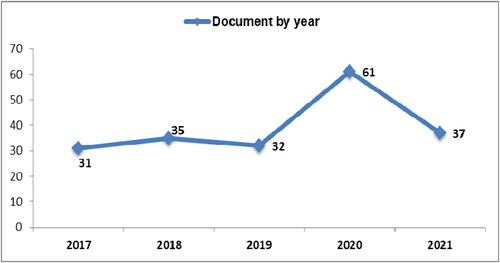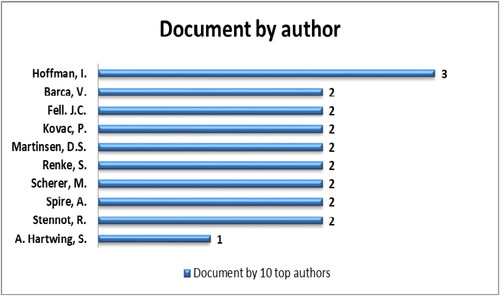Abstract
This study aims to look at the bibliometric trends in state administrative law articles. Then this study uses VOSviewer analysis which aims to analyze publication trends in the form of bibliometric maps collected from the Scopus database. The research findings show that there are 196 articles on state administrative law published in Scopus indexed journals between 2017 and 2021. In terms of document types by year, research documents on state administrative law only increased significantly in 2020. In the type of document based on the author, the author Hoffman is the author with the most documents. In document types by affiliation, research publications from Maria Curie University-Skłodowska are the top document producers. In terms of document types by country, the United States is the top document producer. In the types of documents based on subject, research is dominated by social sciences. Whereas for document types based on citations, articles in 2017–2019 are the results of publications with the most citations. The implications of this research are related to the emphasis on aspects of collaboration and integration in the research partnership system by state administrative law researchers at universities on various continents, especially the Asian continent. Furthermore, this research still has limitations because it only analyzes documents in the Scopus database in 2017–2021. Therefore, we suggest that further research be carried out from a wider range in order to emphasize the need for increased attention to the field of state administrative law.
Impact Statement
This article reviews publication trends from the Scopus database related to state administrative law from 2017-2021. These findings show that there are 196 articles about state administrative law published in Scopus indexed journals between 2017 and 2021, where from the types of documents from year to year, documents research on state administrative law only experienced a significant increase in 2020 (61). In terms of document types by country and region, the United States is the largest document producer (40). In terms of document types based on subject, research is dominated by social sciences (62.08%). Meanwhile, for document types based on citations, articles from 2017-2019 are the publications with the most citations. Currently, international publications on state administrative law are still underdeveloped, and there is not much interest in them. Then, the production of state administrative law research in various Scopus indexed research journals is territorially only produced by countries on the American and European continents, and is still not found in countries on the Asian continent.
1. Introduction
State administrative law is part of public law (Wurman, Citation2021). Then, it also regulates the exercise of powers given to public bodies (Spitzer, Citation2021). Challenges to the practice of this power can be carried out by citizens individually or collectively and by the central government against local governments and vice versa (Coglianese, Citation2021). Then, although state administrative law is always concerned with ensuring public decision-makers act according to the law and are responsible before the law, its development is also mainly due to the desire of the courts to improve the balance of power and to protect the rights and interests of citizens (Sossin, Citation2021). However, experts have described how contemporary regimes in democratic dynamics try to use state administrative law instruments to stay in power and marginalize political opposition (Schotel, Citation2021).
Historically, research on state administrative law was first conducted in 1887 with an article document published in Scopus (Wilson, Citation1887). Then, various studies related to state administrative law have explained that all public actions and decision-making must flow from legal sources to ensure that no individual or position is above the law (Sossin, Citation2021). Furthermore, in the legal context in the era of state administration, the conception of public law regarding criminal law must be prioritized with a paradigm that remains oriented to existing morals (Katz, Citation2018). Then, based on the review of state administrative data, systematic identification of the next steps in facilitating legal investigations is also needed in the future (Cole & Sprang, Citation2020). In addition, the shift in the formulation of fictitious positive administrative decisions has been classified as one of the objects of dispute in the state administrative court. Where fantastical decision arrangements in Indonesia have differences with European Union member countries such as the types of fictitious decisions, time limits, and the advantages and disadvantages of these arrangements (Yasa, Citation2021). Therefore, future state administrative law institutions must be able to adapt to digital automation, where digital-based governance will promise more accurate data-based administrative decisions (Coglianese, Citation2021). The development of state administrative law research is interesting because, in state administration, there is always an extensive role of public administrators who exercise executive power and legislative and judicial powers. Thus, it is considered to have damaged the system of checks and balances and has violated the rule of law (Warren, Citation2019).
Furthermore, according to the literature review, the bibliometric approach was initially a study of library science and information science (Pritchard, Citation1969). The bibliometric technique can classify bibliographic materials from literature sources and has an advantage (Zahra et al., Citation2021). Bibliometrics has been employed as an analytical tool by several writers in journals for article drafting (Ramos-Rodrígue & Ruíz-Navarro, Citation2004), later publications on evaluating journal impact (Glänzel & Moed, Citation2002), and pieces on university rankings (Moed et al., Citation1985; Raan, Citation2005), Later on, bibliometric methods were employed in a variety of different sectors of inquiry, including economics (Feng et al., Citation2017; Guo et al., Citation2020), public administration (Ni et al., Citation2017), politics (Syaifuddin et al., Citation2021), and social sciences (Subandi et al., Citation2021). Furthermore, bibliometric studies have been conducted in several fields of study, including energy (Ante et al., Citation2021; He et al., Citation2020) environment (Sorensen & Jovanović, Citation2021), industry (Gajdzik et al., Citation2020), financial management (Baker et al., Citation2020), big data (Zhang et al., Citation2020), artificial intelligence (Peng & Dai, Citation2020), business (Marczewska & Kostrzewski, Citation2020), Covid-19 (Bonilla-Aldana et al., Citation2020; Felice, Citation2020; Gong et al., Citation2020; Lou, Citation2020; Zhai et al., Citation2020) social networks (Su et al., Citation2020), and others.
In general, Bibliometrics can be effective in providing research data that researchers can use to improve the quality of their research.(Zahra et al., Citation2021) However, there has been no bibliometric research on the development of research on state administrative law until now. Thus, this study attempts to visualize the result of research on state administrative law on a bibliometric map and its research trends in publications in the Scopus database using VOSViewer software. Based on the initial review, research on state administrative law in Scopus journal articles in its database from 2017 to 2021 has been published with a total of 196 pieces. The following is a research article document within the scope of state administrative law based on the Scopus database:
From above, it can be seen that based on the Scopus database from 2017 to 2021, research in the scope of state administrative law totals 196 documents, whereas, in 2020, there has been an increase in publications with 61 document articles published. Therefore, this study aims to analyze the bibliometric characteristics and trends of state administrative law articles taken from the Scopus database. The findings of this study are, of course, believed in providing valuable data for future researchers to understand trends in research and find research novelties for researchers in the field of state administrative law.
Table 1. State administrative law article document.
2. Literature review
Bibliometrics is essentially a statistical analysis of books, articles, and other types of publications that visualize data about the number, authors, and citations of scientific publications and articles. Its objectives are to measure the outcomes of individuals, research teams, institutions, and countries, find national networks, and chart the growth of new fields of science and technology (Fauzan & Jahja, Citation2021; Nurdin et al., Citation2021; Sahoo & Pandey, Citation2020). In the process, the results of the bibliometric analysis will be used to guide further research (Casprini et al., Citation2020; Nurdin, Citation2022; Sun, Citation2020). So, researchers will be able to find something new that will help them improve the quality of their research and maintain it for a long time (Baharuddin et al., Citation2022; Inamdar et al., Citation2020).
Then, in the context of a study of state administrative law, fundamentally, state administrative law is an independent branch of public law that ensures the functioning of state administrative institutions as stipulated in the relevant legal sources. In addition, the study of state administrative law will study the transformation of public administration by the development of administrative law doctrine (Agapova & Palkova, Citation2020; Gluck, Citation2015). In the past few decades, both administrative systems and administrative law were built based on the needs of each country. The national government, which is run by a political body called the “State,” creates a legal environment that allows for the growth of a system of administration and administrative law. Since then, the public has thought that public administration is part of the national community and is built on top of the national government. This means that administrative law is largely state law. The relationship established as a result is called an “administrative state,” and has existed since 1948 (Cassese & D’Alterio, Citation2016).
As the role of government grows along with the role of independent institutions, there is a lot of struggle in the courts over who makes the laws: the legislature or the constitutional institution (Coates, Citation2015). The way administrative law influences how government officials act then has a major effect on democracy and good governance (Coglianese, Citation2021; Collins, Citation2017). In this process, state administrative law needs to be strengthened by establishing rules and decisions, followed by judicial review. However, the current state of administration is still not in line with the main objective (Glicksman & Hammond, Citation2019; Hammond, Citation2016). The way people in modern times understand the law is based on tradition, circumstances, and culture. Most of the time, they don’t become tools of social change overnight. Instead, it happens as a result of things happening in society that cause problems that no one sees. In situations like this, the law is always left behind because the rules are not fast enough to keep up with social changes and have the potential to stop and stay the same (Handrlica, Citation2016, Citation2020; Handrlica et al., Citation2021).
In this research, Scopus was chosen as a sample for several reasons, including comprehensive coverage of citation indexes and digital publications, so that research materials are easily accessible. This database (Scopus) can also be used by researchers to investigate publishing trends, identify leading authors and institutions, and gain insight into the growth and development of their respective research fields (Martín-Martín et al., Citation2021; Vera-Baceta et al., Citation2019). Then, due to the scarcity of literature related to state administrative law, it is necessary to make changes by providing systematic explanations in order to advance state administrative law literature in the Scopus database. Therefore, the literature on “State Administrative Law” is very important to discuss.
3. Method
In this study, each article analyzed is a research article on state administrative law contained in the Scopus database, one of the most significant journal databases globally, and can provide scientific and academic information (Klapka & Slaby, Citation2018). VosViewer analysis was used in this study to visualize and analyze patterns in bibliometric maps (Dharmani et al., Citation2021; Linnenluecke et al., Citation2020), as well as to be able to use shared citation networks in building publication maps, country maps, journal maps, and keyword maps (Fadhlurrohman et al., Citation2021; Hamidah et al., Citation2020).
In the analysis using the VOSViewer tool, we searched and identified articles in the Scopus database about state administrative law, which then filtered the results. Scopus was chosen as a sample because the Scopus database has wide coverage of citation indexes and digital publications, making research literature easily accessible. Researchers can also use this database to examine publishing trends, identify notable authors and institutions, and obtain insight into the growth and development of their respective research disciplines. The paucity of linked literature makes it necessary to improve it by offering systematic explanations in order to advance the state administrative law literature in the Scopus database, which is why the literature of “state administrative law” is vital to discussion.
In the first stage, we determined research keywords that were specific to the study of state administrative law, such as “state administrative law.” In the second stage, we searched for articles in the Scopus database using the keyword “state administrative law,” where the search was limited to the results of journal publications and conferences related to state administrative law. In the third stage, we improve the first results by removing duplicate papers identifying important documents. Furthermore, we found 196 documents discussing state administrative law from 2017 to the end of November 2021. Holding annual publications until the end of November 2021 allows us to highlight and provide a bibliometric analysis of the state administrative law literature landscape on documents published on Scopus that influence the results of the overlay visualization and key point query there.
Therefore, we present the data collected from queries with the main source “state administrative law” along with document types by year, document types by author, document types by affiliation, document types by country or region, document types by subject, and document types based on the citation network. Thus, all categories of documents were applied to fulfill the requirements, as all types of literature are relevant to the research objectives. This emphasizes that evaluation based on abstract extraction covers the entire document. Then a full text analysis is carried out on documents that meet the main full text criteria. Therefore, all the documents contained have the potential to advance state administrative law literature. Using analysis tools, all 196 documents were comprehensively reviewed and analyzed.
4. Result and discussion
Based on data obtained from the Scopus database, articles in the scope of state administrative law published by Scopus first appeared in 1887 (Wilson, Citation1887). However, the number of articles written by authors and published on Scopus tends to fluctuate in the 2017–2021 period. A significant increase only occurred in 2020 with 61 document articles. The following is the distribution of constitutional law articles in several Scopus-indexed journals for the 2017–2021 period, as shown in :
Furthermore, we visualized article data on state administrative law in terms of authorship and affiliation, country, subject, and citations and documents. The first visualization is co-authorship which aims to find out the number of records by the author in writing articles on state administrative law, where each author has several article documents as shown in below:
Based on shows that the top document of the article by the author related to constitutional law is the author of Hoffman, I (3). Then followed by other authors with the same number (2), namely Barca, V., Fell, JC, Kovac, P., Martinsen, DS, Renke, S., Scherer, M., Spire, A., and Steennot, R., as well as A, Hartwig, S (1). Most of these authors are affiliated with several institutions on research publications related to public administrative law, as shown in . These include Maria Curie University-Skłodowska (5), King’s College London (4), Leiden University (4), University of Pennsylvania (3), Universiteit Utrecht (3), Harvard University (3), University of Pretoria (3), Eotvos Lorand Tudomanyegyetem (3), University of Chicago (3), and Cambridge University (3).
Figure 3. State Administrative Law Documents by Affiliation. Source. Analysis Using VosViewer, 2021.
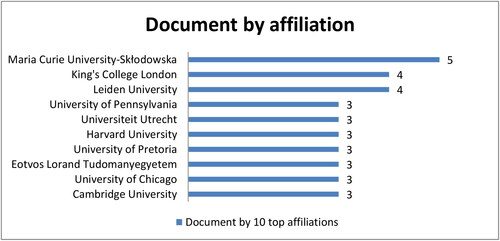
Then, the production of constitutional law research in various research journals that are territorially different is produced by countries in the Americas and the European continent. By Country, the number of studies on state administrative law is dominated by authors based in the United States (40), United Kingdom (31), Poland (18), Netherlands (16), Germany (9), Russian Federation (8), Belgium (7), Hungary (6), Czech Republic (5), and Italy (5). Based on these data, it is conceivable that studies and research on state administrative law in the last 5 years have been minimal. In addition, there has been no research production related to state administrative law for the 2017–2021 period on the Asian continent in Scopus indexed journals, as shown in .
Figure 4. State Administrative Law Documents by Country or Territory. Source. Analysis Using VosViewer, 2021.
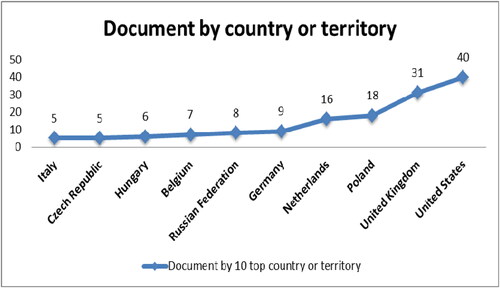
In essence, the factors believed to contribute to this are related to the lack of cross-disciplinary research collaboration and not yet integrated a research partnership system by state administrative law researchers at universities in the Asian continent, so that collaborative efforts to increase research collaboration through an integrated system in expanding the scope of research in the Asian region are very crucial. Therefore, this visualization can strengthen the potential to be developed and researched systematically in studies within the scope of state administrative law, so that future research production is expected to be more diverse, both from Europe, America and other continents, especially the Asian continent.
Furthermore, as shown in , several fields of science are subject to and study approaches within the scope of state administrative law from 2017 to 2021, including social sciences (62.8%), arts and humanities (10.5%), environmental (7.4%), Other (5.1%), economics (3.7%), medicine (3.0%), agricultural (2.0%), computer science (1.7%), engineering (1.7%), biochemistry (1.0%), ass well as earth and plane (1.0%).
Figure 5. State Administrative Law Documents by Subject Area. Source: Analysis Using VosViewer, 2021.
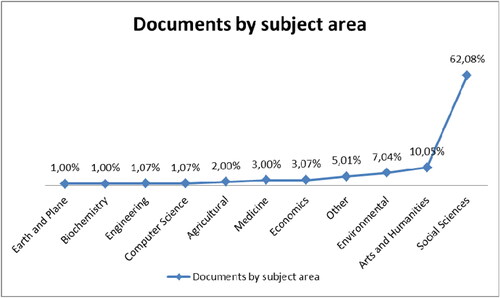
The figure above shows that several research studies related to state administrative law based on their subject areas are dominated by research in the scope of social sciences and minimal in other scientific studies. Then, in the from 2017 to 2021, studies of state administrative law tend to focus on cross-sectoral similar themes, such as the concept of administrative law (Katz, Citation2018), administrative law ideas (Sossin, Citation2021), administrative law decisions (Yasa, Citation2021), administrative law enforcement (Alekhnovich, Citation2021), boundaries administrative law (Nackenoff, Citation2019), development of administrative law (Warren, Citation2019), the influence of administrative law (Medina, Citation2021), the role of administrative law (Merriman, Citation2018), domestic administrative law (Ramraj, Citation2017), welfare state (Rixen, Citation2021), government capacity (Stewart, Citation2017), criminal law (Chiao, Citation2018), and authoritarian elements in administrative law (Schotel, Citation2021). Furthermore, other fields include research on digital automation in administrative law (Coglianese, Citation2021), and review of administrative law data (Cole & Sprang, Citation2020). Thus, it is necessary to elaborate and explore more varied and multi-perspective studies of state administrative law to enrich literacy and develop studies within the scope of state administrative law.
Furthermore, based on excerpts from each document, the visualization in below will show the highest citations and their correlation in each existing record:
Figure 6. Network of State Administrative Law Article from Document Citation Sources. Source. Analysis Using VosViewer, 2021.
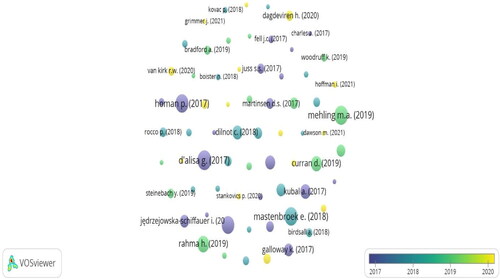
From the analysis results carried out via VOSviewer, the color of the nodes in shows their relationship and publication and conveys the citation relationship. The node size indicates the number of citations received, whereas a larger node indicates publications with more sources. Then, the thickness of the link and the distance between nodes shows the correlation and strength of the connection between nodes. Meanwhile, thicker nodes and closer distances indicate stronger relationships, where Publications with close citation relationships are grouped in nodes of the same color.
The results above have shown bibliographic characteristics, and state administrative law articles from 2017 to 2021 in Scopus indexed journals with 196 documents. In the last 5 years, research on State Administrative Law has only experienced one significant increase, namely in 2020 with 61 article documents. Of course, this analysis and visualization show that international publications on State Administrative Law research have not yet developed, and there are not many interested parties. Then, the production of research on state administrative law in various Scopus indexed research journals, territorially only produced by countries on the American and European continents, and still not found in countries on the Asian continent. In addition, based on the field of study that has been carried out, it is necessary to elaborate and explore a more varied and multi- perspective study of state administrative law to enrich literacy and develop studies within the scope of state administrative law.
5. Conclusion
This study shows that the number of State Administrative Law articles published in Scopus-indexed journals is still not large. In other words, not many writers or researchers have researched and discussed it, especially in Asian countries in the 2017–2021 period. Then, the research results also show that every writer has a very open opportunity to collaborate with researchers or writers from other countries. In addition, the results of this study also provide important insights and contributions regarding the need to improve and develop studies within the scope of state administrative law that are more diverse and multi-perspective from various continents.
Then, the implications of this research are related to the emphasis on aspects of collaboration and integration in the research partnership system by state administrative law researchers in universities on various continents, especially the Asian continent. Furthermore, this research still has limitations because it only analyzes state administrative law documents in the Scopus database for 2017–2021. Therefore, we suggest that further research be carried out with a wider scope to emphasize the need for increased attention to the field of state administrative law, particularly in Asian countries.
Acknowledgments
The author would like to thank all those who have contributed significantly in completing this article.
Disclosure statement
No potential conflict of interest was reported by the author(s).
Additional information
Notes on contributors
Ardiansyah
Ardiansyah is a Lecturer and Researcher at the Department of Law Studies, Faculty of Law, Universitas Islam Riau, Riau, Indonesia. His research interests relate to State Administrative Law, Land Law, and Legal Politics. Email: [email protected].
Wandi
Wandi is a lecturer at the Department of Law Studies, Faculty of Law, Universitas Islam Indragiri, Riau, Indonesia. His research interests relate to Legal Politics and Constitutional Law. Email: [email protected].
Suparto
Suparto is a lecturer at the Department of Law Studies, Faculty of Law, Universitas Islam Riau, Riau, Indonesia. His research interests relate to Constitutional Law and Legal Politics. Email: [email protected].
M. Rafi
M. Rafi is a Lecturer and Researcher at the Department of Government Science, Faculty of Social and Political Sciences, Universitas Riau, Riau, Indonesia. His research interests are related to government science, e-government, governance and local politics. Email: [email protected].
Pahmi Amri
Pahmi Amri is a Lecturer and Researcher at the Department of Government Science, Faculty of Social and Political Sciences, Universitas Islam Riau, Riau, Indonesia. His research interests are related to government studies, transportation policy and government politics. E-mail: [email protected].
References
- Agapova, E., & Palkova, K. (2020). “Public Administration” in the Latvian and Ukrainian administrative and legal traditions. SOCRATES. Rīgas Stradiņa universitātes Juridiskās fakultātes elektroniskais juridisko zinātnisko rakstu žurnāls / SOCRATES. Rīga Stradiņš University Faculty of Law Electronic Scientific Journal of Law, 2(17), 1–11. https://doi.org/10.25143/socr.17.2020.2.066-071
- Alekhnovich, A. O. (2021). Evaluation and adjustment of the law enforcement practice of state control and supervision bodies: Administrative pressure index. Public Administration Issues, 1, 7–29. https://www.scopus.com/inward/record.uri?partnerID=HzOxMe3b&scp=85104858768&origin=inward
- Ante, L., Steinmetz, F., & Fiedler, I. (2021). Blockchain and energy: A bibliometric analysis and review. Renewable and Sustainable Energy Reviews, 137, 110597. https://doi.org/10.1016/j.rser.2020.110597
- Baharuddin, T., Nurmandi, A., Qodir, Z., Jubba, H., & Syamsurrijal, M. (2022). Bibliometric analysis of socio-political research on capital relocation: Examining contributions to the case of Indonesia. Journal of Local Government Issues, 5(1), 17–31. https://doi.org/10.22219/logos.v5i1.19468
- Baker, H. K., Kumar, S., & Pandey, N. (2020). A bibliometric analysis of European Financial Managementʼs first 25 years. European Financial Management, 26(5), 1224–1260. https://doi.org/10.1111/eufm.12286
- Bonilla-Aldana, D. K., Quintero-Rada, K., Montoya-Posada, J. P., Ramírez-Ocampo, S., Paniz-Mondolfi, A., Rabaan, A. A., Sah, R., & Rodríguez-Morales, A. J. (2020). SARS-CoV, MERS-CoV and now the 2019-novel CoV: Have we investigated enough about coronaviruses? – A bibliometric analysis. Travel Medicine and Infectious Disease, 33, 101566. https://doi.org/10.1016/j.tmaid.2020.101566
- Casprini, E., Dabic, M., Kotlar, J., & Pucci, T. (2020). A bibliometric analysis of family firm internationalization research: Current themes, theoretical roots, and ways forward. International Business Review, 29(5), 101715. https://doi.org/10.1016/j.ibusrev.2020.101715
- Cassese, S., & D’Alterio, E. (2016). Introduction: The development of global administrative law. Research Handbook on Global Administrative Law, 1–21. https://doi.org/10.4337/9781783478460.00005
- Chiao, V. (2018). Criminal law in the age of the administrative state. Oxford University Press. https://doi.org/10.1093/oso/9780190273941.001.0001
- Coates, J. C. (2015). The volcker rule as structural law: Implications for cost-benefit analysis and administrative law. Capital Markets Law Journal, 10(4), 447–468. https://doi.org/10.1093/cmlj/kmv040
- Coglianese, C. (2021). Administrative law in the automated state. Daedalus, 150(3), 104–120. https://doi.org/10.1162/daed_a_01862
- Cole, J., & Sprang, G. (2020). Post-implementation of a Safe Harbor law in the U.S.: Review of state administrative data. Child Abuse & Neglect, 101(May 2019), 104320. https://doi.org/10.1016/j.chiabu.2019.104320
- Collins, K. A. (2017). Bureaucracy as the border: Administrative law and the citizen family. Duke Law Journal, 66(8), 1727–1769.
- Dharmani, P., Das, S., & Prashar, S. (2021). A bibliometric analysis of creative industries: Current trends and future directions. Journal of Business Research, 135(July 2020), 252–267. https://doi.org/10.1016/j.jbusres.2021.06.037
- Fadhlurrohman, M. I., Purnomo, E. P., Khairina, E., Fathani, A. T., Salsabila, L., Fadhlurrohman, M. I., Purnomo, E. P., & Khairina, E. (2021). Bibliometrics : Sustainable clean water development and sanitation Indonesia. Journal of Qualitative Inquiry, 12(3), 2159–2175.
- Fauzan, & Jahja, A. S. (2021). Intellectual dynamics of good governance studies: A bibliometric analysis. Journal of Indonesian Economy and Business, 36(2), 155–178. https://doi.org/10.22146/jieb.v36i2.1411
- Felice, F. D. (2020). Coronavirus disease (COVID-19): A machine learning bibliometric analysis. In Vivo, 34, 1613–1617. https://doi.org/10.21873/invivo.11951
- Feng, Y., Zhu, Q., & Lai, K. H. (2017). Corporate social responsibility for supply chain management: A literature review and bibliometric analysis. Journal of Cleaner Production, 158, 296–307. https://doi.org/10.1016/j.jclepro.2017.05.018
- Gajdzik, B., Grabowska, S., Saniuk, S., & Wieczorek, T. (2020). Sustainable development and industry 4.0: A bibliometric analysis identifying key scientific problems of the sustainable industry 4.0. Energies, 13(16), 4254. https://doi.org/10.3390/en13164254
- Glänzel, W., & Moed, H. (2002). Measurement of the impact of journals in bibliometric research. Scientometrics, 53(2), 171–193. https://doi.org/10.1023/A:1014848323806
- Glicksman, R. L., & Hammond, E. (2019). The administrative law of regulatory slop and strategy. SSRN Electronic Journal, 68(8), 1652–1717. https://doi.org/10.2139/ssrn.3396610
- Gluck, A. R. (2015). The ripple effect of “leg-reg” on the study of legislation & administrative law in the law school curriculum. Journal of Legal Education, 65(1), 121–163.
- Gong, Y., Ma, T.-C., Xu, Y.-Y., Yang, R., Gao, L.-J., Wu, S.-H., Li, J., Yue, M.-L., Liang, H.-G., He, X., & Yun, T. (2020). Early research on COVID-19: A bibliometric analysis. Innovation (Cambridge (Mass.)), 1(2), 100027. https://doi.org/10.1016/j.xinn.2020.100027
- Guo, F., Li, F., Lv, W., Liu, L., & Duffy, V. G. (2020). Bibliometric analysis of affective computing researches during 1999–2018. International Journal of Human–Computer Interaction, 36(9), 801–814. https://doi.org/10.1080/10447318.2019.1688985
- Hamidah, I., Sriyono, S., & Hudha, M. N. (2020). A bibliometric analysis of COVID-19 research using vosviewer. Indonesian Journal of Science and Technology, 5(2), 209–216. https://doi.org/10.17509/ijost.v5i2.24522
- Hammond, E. (2016). Double deference in administrative law. Columbia Law Review, 116(7), 1705–1772.
- Handrlica, J. (2016). International administrative law and administrative acts. Czech Yearbook of Public & Private International Law, 7(April), 105–117.
- Handrlica, J. (2020). A treatise for international administrative law. Lawyer Quarterly, 10(4), 462–475.
- Handrlica, J., Šarapajev, V., & Blahoudková, G. (2021). “BLACK SWANS” in administrative law. The Lawyer Quarterly, II, 20–30.
- He, S., Zhu, D., Chen, Y., Liu, X., Chen, Y., & Wang, X. (2020). Application and problems of emergy evaluation: A systemic review based on bibliometric and content analysis methods. Ecological Indicators, 114, 106304. https://doi.org/10.1016/j.ecolind.2020.106304
- Inamdar, Z., Raut, R., Narwane, V. S., Gardas, B., Narkhede, B., & Sagnak, M. (2020). A systematic literature review with bibliometric analysis of big data analytics adoption from period 2014 to 2018. Journal of Enterprise Information Management, 34(1), 101–139. https://doi.org/10.1108/JEIM-09-2019-0267
- Katz, L. D. (2018). Criminal law: Political or moral? Defending a complementary conception of criminal law in the age of the administrative state. Jerusalem Review of Legal Studies, 17(1), 111–127. https://doi.org/10.1093/jrls/jly003
- Klapka, O., & Slaby, A. (2018). Visual analysis of search results in the scopus database. In The International Conference on Theory and Practice of Digital Libraries (pp. 340–343). Springer. https://doi.org/10.1007/978-3-030-00066-0_36
- Linnenluecke, M. K., Marrone, M., & Singh, A. K. (2020). Conducting systematic literature reviews and bibliometric analyses. Australian Journal of Management, 45(2), 175–194. https://doi.org/10.1177/0312896219877678
- Lou, J. (2020). Coronavirus disease 2019: A bibliometric analysis and review. European Review for Medical and Pharmacological Sciences, 24(6), 3411–3421. https://doi.org/10.26355/eurrev_202003_20712
- Marczewska, M., & Kostrzewski, M. (2020). Sustainable business models: A bibliometric performance analysis. Energies, 13(22), 6062. https://doi.org/10.3390/en13226062
- Martín-Martín, A., Thelwall, M., Orduna-Malea, E., & Delgado López-Cózar, E. (2021). Google Scholar, Microsoft Academic, Scopus, Dimensions, Web of Science, and OpenCitations’ COCI: A multidisciplinary comparison of coverage via citations. Scientometrics, 126(1), 871–906. https://doi.org/10.1007/s11192-020-03690-4
- Medina, C. N. G. (2021). The structure of the State and its influence on Administrative Law: Analysis in the German, Spanish and French legal systems. Revista Republicana, 2021(31), 71–98. https://doi.org/10.21017/Rev.Repub.2021.v31.a108
- Merriman, B. (2018). Modern state-federal conflict: The central role of administration and administrative law. In Handbook of American public administration (pp. 67–80). Elsevier. https://api.elsevier.com/content/abstract/scopus_id/85072653696
- Moed, H. F., Burger, W. J. M., Frankfort, J. G., & Van Raan, A. (1985). Use of bibliometric data for measurement of university research performance. Research Policy, 14(3), 131–149. https://doi.org/10.1016/0048-7333(85)90012-5
- Nackenoff, C. (2019). Sexual harassment trajectories: Limits of (current) law and of the administrative state. Journal of Women, Politics and Policy, 40(1), 21–41. https://doi.org/10.1080/1554477X.2019.1563411
- Ni, C., Sugimoto, C. R., & Robbin, A. (2017). Examining the evolution of the field of public administration through a bibliometric analysis of public administration review. Public Administration Review, 77(4), 496–509. https://doi.org/10.1111/puar.12737
- Nurdin, B. V., Hutagalung, S. S., Kurniawan, R. C., Hermawan, D., & Yulianto, (2021). Bibliometric analysis on governance index topics using scopus database and vosviewer. Journal of Physics: Conference Series, 1933(1),012047. https://doi.org/10.1088/1742-6596/1933/1/012047
- Nurdin, I. N. (2022). Trend on public administration research: Bibliometric analysis. TRANSFORMASI: Jurnal Manajemen Pemerintahan, 14(1), 57–65. https://doi.org/10.33701/jtp.v14i1.2530
- Peng, X., & Dai, J. (2020). A bibliometric analysis of neutrosophic set: Two decades review from 1998 to 2017. Artificial Intelligence Review, 53(1), 199–255. https://doi.org/10.1007/s10462-018-9652-0
- Pritchard, A. (1969). Bibliography statistics or bibliometrics. The Journal of Documentation 1969, 25(4), 338–349.
- Raan, A. V. (2005). Fatal attraction: conceptual and methodological problems in ranking universities using bibliometric methods. Scientometrics, 62(1), 133–143.
- Ramos-Rodrígue, A. R., & Ruíz-Navarro, J. (2004). Changes in the intellectual structure of strategic management research: A bibliometric study of the Strategic Management Journal, 1980-2000. Strategic Management Journal, 25(10), 981–1004. https://doi.org/10.1002/smj.397
- Ramraj, V. V. (2017). Transnational non-state regulation and domestic administrative law. In Comparative administrative law: Second edition (pp. 582–597). Edward Elgar. https://api.elsevier.com/content/abstract/scopus_id/85044132712
- Rixen, S. (2021). Disaster-sensitive infrastructure in the health welfare state: The COVID-19 pandemic as live stress test of the administrative organization law. Die Verwaltung, 54(3), 319–340. https://doi.org/10.3790/verw.54.3.319
- Sahoo, S., & Pandey, S. (2020). Bibliometric analysis and visualization of global ocean acidification research. Science & Technology Libraries, 39(4), 414–431. https://doi.org/10.1080/0194262X.2020.1776194
- Schotel, B. (2021). Administrative law as a dual state. Authoritarian elements of administrative law. Hague Journal on the Rule of Law, 13(1), 195–222. https://doi.org/10.1007/s40803-021-00156-4
- Sorensen, R. M., & Jovanović, B. (2021). From nanoplastic to microplastic: A bibliometric analysis on the presence of plastic particles in the environment. Marine pollution bulletin, 163, 111926. https://doi.org/10.1016/j.marpolbul.2020.111926
- Sossin, L. (2021). The idea of administrative law and the expansion of the administrative state. In Handbook of public administration: Fourth edition (pp. 40–54). Routledge. https://www.scopus.com/inward/record.uri?partnerID=HzOxMe3b&scp=85110963148&origin=inward
- Spitzer, M. L. (2021). Review essay: The dubious morality of modern administrative law by Richard Epstein. SSRN Electronic Journal, 21(16), 1–45. https://doi.org/10.2139/ssrn.3865308
- Stewart, R. B. (2017). State regulatory capacity and administrative law and governance under globalization. In Administrative law from the inside out: Essays on themes in the work of Jerry L. Mashaw (pp. 474–500). University School of Law. https://doi.org/10.1017/9781316671641.020
- Su, Y.-S., Lin, C.-L., Chen, S.-Y., & Lai, C.-F. (2020). Bibliometric study of social network analysis literature. Library Hi Tech, 38(2), 420–433. https://doi.org/10.1108/LHT-01-2019-0028
- Subandi, Y., Nurmandi, A., Qodir, Z., Jubba, H., Purwaningsih, T., Nur Rochimah, T., & Syamsurrijal, M. (2021). Bibliometric analysis and visualization harm reduction in Indonesia Indexed in Scopus. In Research Square (pp. 0–18). https://doi.org/10.21203/rs.3.rs-817806/v1
- Sun, J. (2020). Mapping of the world rice research: A bibliometric analysis of top papers during 2008–2018. Annals of Library and Information Studies, 67(1), 56–66. https://api.elsevier.com/content/abstract/scopus_id/85087125201
- Syaifuddin, M., Suswanta, S., Misran, M., & Abd. Rasyid, S. B. (2021). Mapping political theory using bibliometric analysis. JWP (Jurnal Wacana Politik), 6(2), 163–173. https://doi.org/10.24198/jwp.v6i2.31870
- Vera-Baceta, M. A., Thelwall, M., & Kousha, K. (2019). Web of Science and Scopus language coverage. Scientometrics, 121(3), 1803–1813. https://doi.org/10.1007/s11192-019-03264-z
- Warren, K. F. (2019). Has democratic governance and the rule of law been compromised by the continued growth of the administrative state? Journal of Chinese Governance, 4(1), 15–33. https://doi.org/10.1080/23812346.2018.1541657
- Wilson, W. (1887). The study of administration. Political Science Quarterly, 2(2), 197–222. https://doi.org/10.2307/2139277
- Wurman, B. I. (2021). Administrative law theory and fundamentals: An integrated approach. West Academic Publishing. https://faculty.westacademic.com/Book/Detail?id=337041#teachingresources
- Yasa, P. G. A. S. (2021). Position of fictitious positive administrative decisions as dispute object of state administrative court: Indonesia Omnibus Law Perspective. Journal of Legal, Ethical and Regulatory Issues, 24(5), 1–12. https://www.scopus.com/inward/record.uri?partnerID=HzOxMe3b&scp=85107802062&origin=inward
- Zahra, A. A., Nurmandi, A., Tenario, C. B., Rahayu, R., Benectitos, S. H., Mina, F. L. P., & Haictin, K. M. (2021). Bibliometric analysis of trends in theory-related policy publications. Emerging Science Journal, 5(1), 96–110. https://doi.org/10.28991/esj-2021-01261
- Zhai, F., Zhai, Y., Cong, C., Song, T., Xiang, R., Feng, T., Liang, Z., Zeng, Y., Yang, J., Yang, J., & Liang, J. (2020). Research progress of coronavirus based on bibliometric analysis. International Journal of Environmental Research and Public Health, 17(11), 3766. https://doi.org/10.3390/ijerph17113766
- Zhang, X., Yu, Y., & Zhang, N. (2020). Sustainable supply chain management under big data: A bibliometric analysis. Journal of Enterprise Information Management, 34(1), 427–445. https://doi.org/10.1108/JEIM-12-2019-0381

